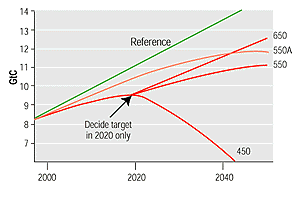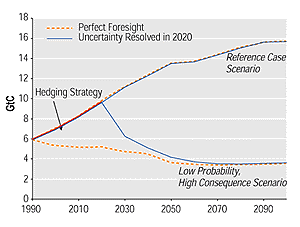10 Decision Analytical Frameworks
|

Figure TS.10a: Optimal carbon dioxide emissions strategy, using
a cost-effectiveness approach.
|
10.1 Scope for and New Developments
in Analyses for Climate Change Decisions
Decision making frameworks (DMFs) related to climate change involve multiple
levels ranging from global negotiations to individual choices and a diversity
of actors with different resource endowments, and diverging values and aspirations.
This explains why it is difficult to arrive at a management strategy that is
acceptable for all. The dynamic interplay among economic sectors and related
social interest groups makes it difficult to arrive at a national position to
be represented at international fora in the first place. The intricacies of
international climate negotiations result from the manifold often-ambiguous
national positions as well as from the linkages of climate change policy with
other socio-economic objectives.
No DMF can reproduce the above diversity in its full richness. Yet analysts
have made significant progress in several directions since SAR. First, they
integrate an increasing number of issues into a single analytical framework
in order to provide an internally consistent assessment of closely related components,
processes, and subsystems. The resulting integrated assessment models (IAMs)
cited in Chapter
9, and indeed throughout the whole report, provide useful insights into
a number of climate policy issues for policymakers. Second, scientists pay increasing
attention to the broader context of climate related issues that have been ignored
or paid marginal attention previously. Among other factors, this has fostered
the integration of development, sustainability and equity issues into the present
report.
Climate change is profoundly different from most other environmental problems
with which humanity has grappled. A combination of several features lends the
climate problem its uniqueness. They include public good issues raising from
the concentration of GHGs in the atmosphere that requires collective global
action, the multiplicity of decision makers ranging from global down to the
micro level of firms and individuals, and the heterogeneity of emissions and
their consequences around the world. Moreover, the long-term nature of climate
change originates from the fact that it is the concentration of GHGs that matters
rather than their annual emissions and this feature raises the thorny issues
of intergenerational transfers of wealth and environmental goods and bads. Next,
human activities associated with climate change are widespread, which makes
narrowly defined technological solutions impossible, and the interactions of
climate policy with other broad socio-economic policies are strong. Finally,
large uncertainties or in some areas even ignorance characterize many aspects
of the problem and require a risk management approach to be adopted in all DMFs
that deal with climate change.
|

Figure TS.10b: Optimal hedging strategy for low probability, high
consequence scenario using a cost-benefits optimization approach.
|
Policymakers therefore have to grapple with great uncertainties
in choosing the appropriate responses. A wide variety of tools have been applied
to help them make fundamental choices. Each of those decision analysis frameworks
(DAFs) has its own merits and shortcoming through its ability to address some
of the above features well, but other facets less adequately. Recent analyses
with well-established tools such as cost-benefit analysis as well as newly
developed frameworks like the tolerable windows or safe landing approach provide
fresh insights into the problem.
Figure TS.10a shows the results of a cost-effectiveness
analysis exploring the optimal hedging strategy when uncertainty with respect
to the long-term stabilization target is not resolved until 2020, suggesting
that abatement over the next few years would be economically valuable if there
is a significant probability of having to stay below ceilings that would be
otherwise reached within the characteristic time scales of the systems producing
greenhouse gases. The degree of near-term hedging in the above analysis is sensitive
to the date of resolution of uncertainty, the inertia in the energy system,
and the fact that the ultimate concentration target (once it has been revealed)
must be met at all costs. Other experiments, such as those with cost-benefit
models framed as a Bayesian decision analysis problem show that optimal near-term
(next two decades) emission paths diverge only modestly under perfect foresight,
and hedging even for low-probability, high-consequence scenarios (see Figure
TS.10b). However, decisions about near-term climate policies may have to
be made while the stabilization target is still being debated. Decision-making
therefore should consider appropriate hedging against future resolution of that
target and possible revision of the scientific insights in the risks of climate
change. There are significant differences in the two approaches. With a cost-effectiveness
analysis, the target must be made regardless of costs. With a cost-benefit analysis,
costs and benefits are balanced at the margin. Nevertheless, the basic message
is quite similar and involves the explicit incorporation of uncertainty and
its sequential resolution over time. The desirable amount of hedging depends
upon one's assessment of the stakes, the odds, and the costs of policy
measures. The risk premium - the amount that society is willing to pay
to reduce risk - ultimately is a political decision that differs among
countries.
Cost-effectiveness analyses seek the lowest cost of achieving an environmental
target by equalizing the marginal costs of mitigation across space and time.
Long-term cost-effectiveness studies estimate the costs of stabilizing atmospheric
CO2 concentrations at different levels and find that the costs of
the 450ppmv ceiling are substantially greater than those of the 750ppmv limit.
Rather than seeking a single optimal path, the tolerable windows/safe landing
approach seeks to delineate the complete array of possible emission paths that
satisfy externally defined climate impact and emission cost constraints. Results
indicate that delaying near-term effective emission reductions can drastically
reduce the future range of options for relatively tight climate change targets,
while less tight targets offer more near-term flexibility.
10.2 International Regimes and Policy Options
The structure and characteristics of international agreements on climate change
will have a significant influence on the effectiveness and costs and benefits
of mitigation. The effectiveness and the costs and benefits of an international
climate change regime (such as the Kyoto Protocol or other possible future agreements)
depend on the number of signatories to the agreement and their abatement targets
and/or policy commitment. At the same time, the number of signatories depends
on the question of how equitably the commitments of participants are shared.
Economic efficiency (minimizing costs by maximizing participation) and equity
(the allocation of emissions limitation commitments) are therefore strongly
linked.
There is a three-way relationship between the design of the international regime,
the cost-effectiveness/efficiency of climate policies, and the equity of the
consequent economic outcomes. As a consequence, it is crucial to design the
international regime in a way that is considered both efficient and equitable.
The literature presents different theoretical strategies to optimize an international
regime. For example, it can be made attractive for countries to join the group
that commits to specific targets for limitation and reduction of emissions by
increasing the equity of a larger agreement - and therefore its efficiency
- through measures like an appropriate distribution of targets over time,
the linkage of the climate debate with other issues ("issue linkage"),
the use of financial transfers to affected countries ("side payments"),
or technology transfer agreements.
Two other important concerns shape the design of an international regime: "implementation"
and "compliance". The effectiveness of the regime, which is a function
of both implementation and compliance, is related to actual changes of behaviour
that promote the goals of the accord. Implementation refers to the translation
of international accords into domestic law, policy, and regulations by national
governments. Compliance is related to whether and to what extent countries do
in fact adhere to provisions of an accord. Monitoring, reporting, and verification
are essential for the effectiveness of international environmental regimes,
as the systematic monitoring, assessment, and handling of implementation failures
have been so far relatively rare. Nonetheless, efforts to provide "systems
of implementation review" are growing, and are already incorporated into
the UNFCCC structure. The challenge for the future is to make them more effective,
especially by improving data on national emissions, policies, and measures.
|

